A Physicist’s Introduction to Topology: Connections to Bosons, Fermions, and... Daniel Walsh
advertisement
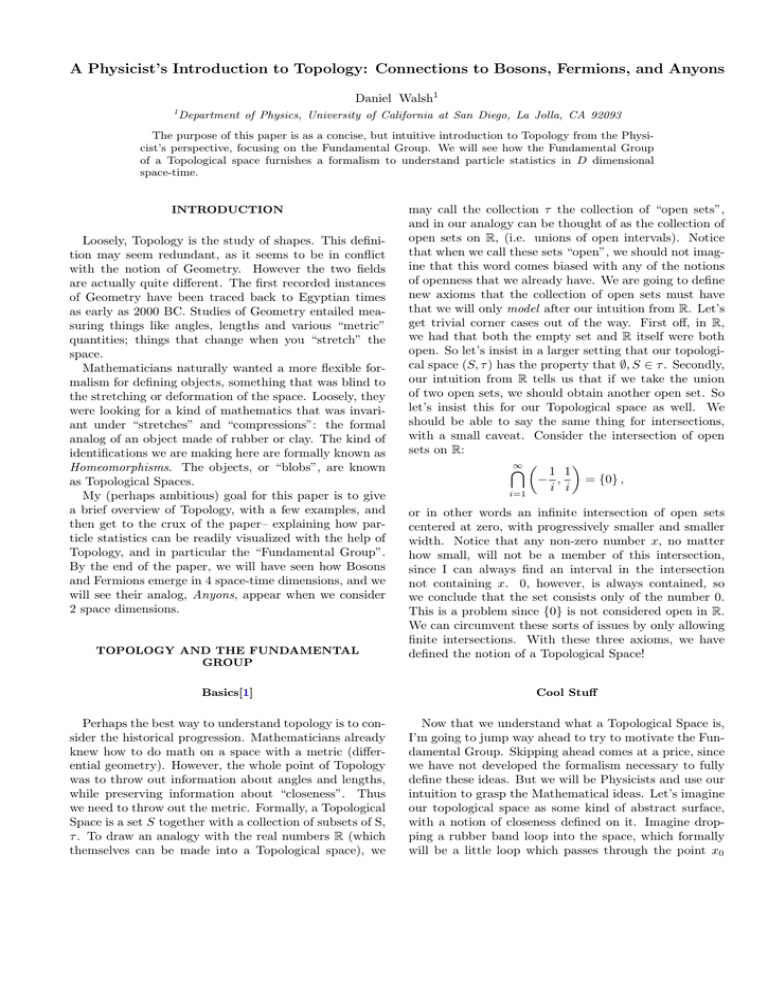
A Physicist’s Introduction to Topology: Connections to Bosons, Fermions, and Anyons
Daniel Walsh1
1
Department of Physics, University of California at San Diego, La Jolla, CA 92093
The purpose of this paper is as a concise, but intuitive introduction to Topology from the Physicist’s perspective, focusing on the Fundamental Group. We will see how the Fundamental Group
of a Topological space furnishes a formalism to understand particle statistics in D dimensional
space-time.
INTRODUCTION
Loosely, Topology is the study of shapes. This definition may seem redundant, as it seems to be in conflict
with the notion of Geometry. However the two fields
are actually quite different. The first recorded instances
of Geometry have been traced back to Egyptian times
as early as 2000 BC. Studies of Geometry entailed measuring things like angles, lengths and various “metric”
quantities; things that change when you “stretch” the
space.
Mathematicians naturally wanted a more flexible formalism for defining objects, something that was blind to
the stretching or deformation of the space. Loosely, they
were looking for a kind of mathematics that was invariant under “stretches” and “compressions”: the formal
analog of an object made of rubber or clay. The kind of
identifications we are making here are formally known as
Homeomorphisms. The objects, or “blobs”, are known
as Topological Spaces.
My (perhaps ambitious) goal for this paper is to give
a brief overview of Topology, with a few examples, and
then get to the crux of the paper– explaining how particle statistics can be readily visualized with the help of
Topology, and in particular the “Fundamental Group”.
By the end of the paper, we will have seen how Bosons
and Fermions emerge in 4 space-time dimensions, and we
will see their analog, Anyons, appear when we consider
2 space dimensions.
TOPOLOGY AND THE FUNDAMENTAL
GROUP
may call the collection τ the collection of “open sets”,
and in our analogy can be thought of as the collection of
open sets on R, (i.e. unions of open intervals). Notice
that when we call these sets “open”, we should not imagine that this word comes biased with any of the notions
of openness that we already have. We are going to define
new axioms that the collection of open sets must have
that we will only model after our intuition from R. Let’s
get trivial corner cases out of the way. First off, in R,
we had that both the empty set and R itself were both
open. So let’s insist in a larger setting that our topological space (S, τ ) has the property that ∅, S ∈ τ . Secondly,
our intuition from R tells us that if we take the union
of two open sets, we should obtain another open set. So
let’s insist this for our Topological space as well. We
should be able to say the same thing for intersections,
with a small caveat. Consider the intersection of open
sets on R:
∞ \
1 1
= {0} ,
− ,
i i
i=1
or in other words an infinite intersection of open sets
centered at zero, with progressively smaller and smaller
width. Notice that any non-zero number x, no matter
how small, will not be a member of this intersection,
since I can always find an interval in the intersection
not containing x. 0, however, is always contained, so
we conclude that the set consists only of the number 0.
This is a problem since {0} is not considered open in R.
We can circumvent these sorts of issues by only allowing
finite intersections. With these three axioms, we have
defined the notion of a Topological Space!
Basics[1]
Cool Stuff
Perhaps the best way to understand topology is to consider the historical progression. Mathematicians already
knew how to do math on a space with a metric (differential geometry). However, the whole point of Topology
was to throw out information about angles and lengths,
while preserving information about “closeness”. Thus
we need to throw out the metric. Formally, a Topological
Space is a set S together with a collection of subsets of S,
τ . To draw an analogy with the real numbers R (which
themselves can be made into a Topological space), we
Now that we understand what a Topological Space is,
I’m going to jump way ahead to try to motivate the Fundamental Group. Skipping ahead comes at a price, since
we have not developed the formalism necessary to fully
define these ideas. But we will be Physicists and use our
intuition to grasp the Mathematical ideas. Let’s imagine
our topological space as some kind of abstract surface,
with a notion of closeness defined on it. Imagine dropping a rubber band loop into the space, which formally
will be a little loop which passes through the point x0
2
in our space. This is actually a function f : [0, 1] → S,
with the property that x0 = f (0) = f (1). Now imagine stretching the band around in the Topological Space,
keeping the loop passing through x0 . Since we are talking
Topology here, any two loops based at the point x0 will
be thought of as identical if one can be “stretched” into
the other continuously. The notion of “stretchability”
is formally called homotopy in Mathematical parlance.
The wonderful reality is that the collection of all “essentially different” loops in our topological space has a lot
of great properties– there is actually a sensible way to
add two loops together and obtain a new loop, there’s an
identity loop and there’s even a notion of an inverse loop,
and addition of loops is associative. Therefore this collection actually forms a group! Mathematicians call this
object the Fundamental Group, which is often denoted
as π1 .
Let us explore the Fundamental Group with some
examples.[2].
1. Rn : Any loop can be contracted down to a point
in an n-dimensional plane. Then π1 (R) = 0 (trivial
group)
2. S0 : The 0-dimensional sphere consists of two disconnected points. Then any loop can be trivially contracted (it already is). Then π1 (S0 ) = 0.
Roughly, the dimensionality is too small to get
knotted up.
3. S1 : The 1-dimensional sphere is a circle. Then we
can think of many kinds of loops. We may choose to
wrap any integer number of times around the circle
(even in the reverse direction) Then π1 (S1 ) = Z.
4. Sn , n > 1: The n-dimensional sphere for n > 1 is
difficult to visualize for n > 2, but for n = 2 the
answer should be intuitively clear. Any loop can
just be reduced to a single point. It turns out this
is always possible in higher dimensions. π1 (Sn ) = 0
for n > 1.
This list may sound rather boring so far, but for the
record Mathematicians also have the higher homotopy
groups to think about, which encode information about
how higher dimensional spheres can be projected down
into Topological spaces and then deformed around.
CONNECTION TO PHYSICS [3]
We want to understand how the Physics is elucidated
by Topology, particularly in the context of the statistics
of particles. Take the simplest example of two identical
particles in an n-dimensional space. What is the configuration space S of this system? Naively, we may expect
it to be Rn × Rn . However this ignores the indistinguishability. Instead, notice that we may first extract
the center-of-mass coordinate as an independent configuration dimension. Therefore, the space decomposes into
a cartesian product:
S = En × r(n, 2),
where En is the Euclidean space in n dimensions, and
r(n, 2) is the so-called “relative” space, consisting of the
relative particle configurations. Since we don’t allow the
particles to overlap, we are interested in this relative
space which excludes the configuration where the two
particles are coincident. Let us examine the nature of
this relative space. We can completely characterize the
system by defining the position of one of the particles,
since then the other particle can be determined as its
negative. To this end, we might expect the answer to be
En − {0} = Sn−1 × (0, ∞). However, since the particles
are indistinguishable, we must identify v ≡ −v. In this
identification, we “fold up” the spherical component of
the Cartesian product into a projective plane: [3]
r(n, 2) − {0} = RP n−1 × (0, ∞).
We want to describe the theory of Quantum Mechanics
without resorting to an unnatural imposition of particle
statistics. Instead, we want the statistics to drop out
from the Topology. Suppose we want to describe our
system with a one-dimensional, complex Hilbert space
hx [2, 3]. This is the space in which our quantum wavefunction Ψ(x) lives. Then when we solve the Schrödinger
Equation as usual. However, the configuration space is
no longer purely Euclidean, so we need a notion of a Covariant derivative to even write the equation down:
Dk ≡
∂
− ibk (x),
∂xk
where bk is a function that is based on the system as
well as the choice of gauge. However, the function bk
is not desired at the non-singular points, otherwise we
would be introducing a new field, like the vector potential. So we require that bk be zero away from any singular points. The result of this is ensuring that a parallel
transport of our state vector around a point not enclosing a singularity is zero– the path is contractible. On the
other hand, if we take a path that encloses a singularity
(where the Covariant Derivative is not trivial), Differential Geometry tells us that we observe a non-trivial parallel transport. In this particular instance, the Hilbert
space consists of a one-dimensional complex wavefunction, so the change in Ψ(x) around a singularity boils
down to a simple phase factor:
Ψ(x) → eiξ Ψ(x).
3
The interesting thing is that ξ is a free parameter that
describes what’s happening at the singularity, which encodes information about the particle statistics. If we
wrap n times around the singularity, then we pick up
n factors. Now here’s where Topology kicks in.
the conclusion is that the Fundamental Group is Z. Let’s
think a little bit harder just to make sure. What would
the element `2 be? Now our path consists of two traversals of `: two parallel, diametric lines cutting across the
disk. As shown in the figure, we are going to consider
what happens when we rotate a pair of portals a halfrotation.
Back to Topology Again
In the previous section, we saw how when a system
moves around a closed path in configuration space, it
sometimes picks up a phase factor. What Topology affords us is the ability to discern when two seemingly different paths acquire the same phase factor. Let’s take a
more concrete example. We saw that the interesting part
of the configuration space of two indistinguishable particles in three dimensions looks like RP 2 . First, let’s imagine the Fundamental Group for this space. Using the visualization of a 2-sphere with antipodal points identified,
let us realize this identification by popping the North and
South hemispheres apart, and rotating them relative to
each other by a rotation of π. Snap them back together.
This is allowed because antipodal points are identified.
Now, notice if we deflate, or flatten the sphere so that
the North and South poles meet, we automatically identify all the non-equatorial points. We are now left with
a disk. We still need to identify the equatorial points,
so let’s just keep in mind that antipodal points of the
disk are to be identified. This is a helpful model of the
projective plane. Now let’s visualize elements of the Fundamental Group. The trivial element e can be visualized
as a simple loop in the middle of the disk somewhere.
Can we do anything else? Yes. We haven’t used the
boundary identification in our loops yet. How about a
loop that starts on the boundary, moves across the diameter of the disk to the opposite side, and then pops
through the portal right back where it started? A little
thinking should convince you that this loop cannot be
deformed into the trivial loop– the antipodal points are
“pinned”, and there is no way to change that.
FIG. 2: Paths whose corresponding group element is `2 . This
is achieved by traversing the path corresponding to ` twice.
If we rotate the portals as shown in FIG. 4, then we
get
FIG. 3: Trying to untie the path
Then we can just pull the loop through, and get
FIG. 4: Paths whose corresponding group element is `2 are
contractible!
FIG. 1: Two paths from different equivalence classes. e is
contractible, where ` is not.
One might expect that this group element– call it `–
acts as a generator for the Fundamental Group, and so
With this observation, and some intuition, this tells us
something profound– the Fundamental Group of RP 2 is
Z2 , consisting of only e and `. This means that whatever
factor we pick up when traversing the singularity must
disappear upon another traversal. Therefore the factor is
4
either 1 or −1, and these two cases correspond to Bosons
and Fermions.
gories like they did in three or more dimensions, types of
particles in two dimensions are indexed by a continuous
real parameter ξ. Such particles are collectively known
as Anyons[4].
Anyons
It turns out that a similar argument follows in higher
dimensions. There are always Bosons and Fermions in
n-dimensions for n ≥ 3. However, something unusual
happens when we consider n = 2. The peculiar thing
that happens is that RP 1 = S1 . A fantastic way to visualize this is to realize the antipodal identification of
the circle with our intuition for rubber bands. Sometimes when you need a tighter band, you twist it into
a figure eight, and then fold the two lobes of the eight
together. In doing this, you’re creating the Real Projective Line because you’re bringing antipodal points together. And the band still looks like a band, it just loops
around twice now. Now that we’ve convinced ourselves
that RP 1 is S 1 , let’s consider the Fundamental Group.
As discussed in the Topology section, it’s easy to visualize why the π1 S 1 = Z. But this means something profound physically– every time we traverse the singularity
we really do return with a new phase. There’s no peculiar identifications that constrain what our phase factor
can be. Consequently, rather than falling into two cate-
Acknowledgements
I would like to thank Professor McGreevy for his support and calm composure when explaining concepts to
me. I very much appreciate his encouragement, teaching and guidance. I would also like to thank Franciscus
Alex Rebro, my Math friend from UC Riverside for many
enriching conversations on the rich subject of Differential Geometry and Topology, as well as Group Theory.
I would like to thank Shauna Kravec for informing me
of the existence of John Preskill’s Lecture Notes on the
subject of Quantum Computation, which included some
Knot Theoretic topics.
[1] B. Mendelson, Introduction to Topology (Dover Books,
1990).
[2] A. S. Schwarz (1994).
[3] J. Leinaas and J. Myrheim, Nuovo Cim. B37, 1 (1977).
[4] J. Preskill, On the theory of identical particles (2004).
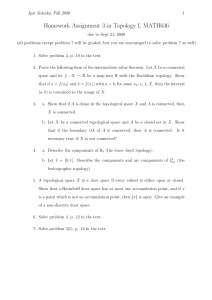
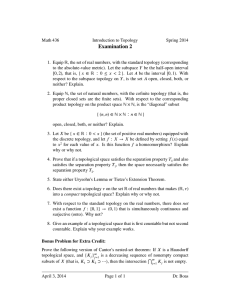
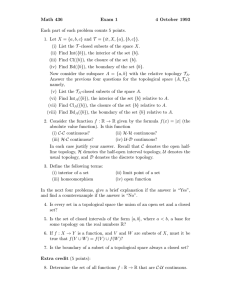
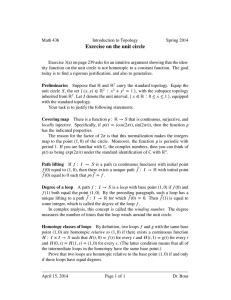
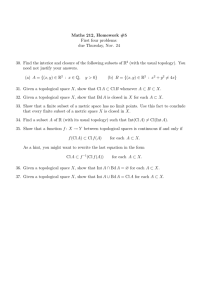
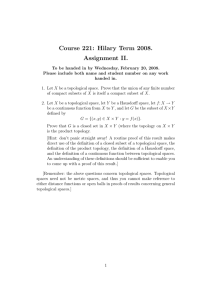
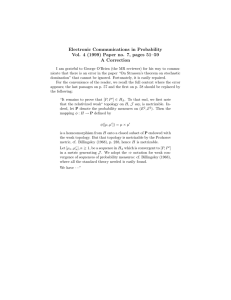
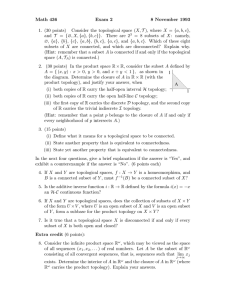
![MA342A (Harmonic Analysis 1) Tutorial sheet 2 [October 22, 2015] Name: Solutions](http://s2.studylib.net/store/data/010415895_1-3c73ea7fb0d03577c3fa0d7592390be4-300x300.png)